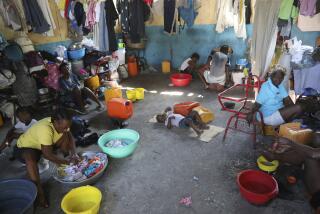Haitian earthquake victims relocated to new camps
- Share via
Reporting from Port-Au-Prince, Haiti — Relief organizations on Saturday began to move Haitians from tent camps that are in danger of flooding to new camps on the perimeter of the city, part of a larger plan to decentralize the population after January’s devastating earthquake.
After a heavy rain the night before, buses carried 62 people from a bedraggled camp on a defunct golf course to a barren field 10 miles northwest of the city.
Aid workers helped Romaine Vincent Donal, 44, load her belongings in wheelbarrows. People cheered her on as she was first up a hill to the buses. She said she couldn’t wait to leave, though she didn’t know where she was going.
Five hours later, she walked across a dust-blown clearing looking for a latrine. With little rain in this part of the country, the terrain is dry and spotted with spiny shrubs and cactus.
Wind constantly funnels between two mountain ranges and kicks up talc-like dust.
“I don’t like it,” she said. “It’s like a wasteland.”
Dump trucks were unloading rubble and gravel to tamp down the dust. But the only thing to offer shade or shelter from the wind was a few white tents, listing and flapping hard.
“I think they should have gotten things better organized before they brought us out here,” Donal said. “The way they were explaining it, this place was going to be great. They lied.”
Workers were still putting up latrines and tents in a last-minute operation as the rainy season bears down on the capital.
Thousands of people in Port-au-Prince are living on dangerously steep and muddy slopes or on tidal flats that are routinely inundated. More than 1.7 million people were displaced in the capital alone; the quake killed more than 200,000.
Although there is open land closer to the city, landowners have not been willing to give it up, according to news reports.
United Nations officials and foreign aid groups have complained that the government has been slow to secure new sites and sign off on relocation plans.
President Rene Preval on Saturday toured the new camp, called Corail Cesselesse, with the just-arrived residents.
In an interview, he said this was part of his broader reconstruction plan to free Port-au-Prince from congestion and create better-designed population centers throughout the country.
“Port-au-Prince was already too crowded,” Preval said. “Scientists have always said this is the normal extension of Port-au-Prince.”
Why so far? “Here the state has a lot of land.”
More to Read
Sign up for Essential California
The most important California stories and recommendations in your inbox every morning.
You may occasionally receive promotional content from the Los Angeles Times.











